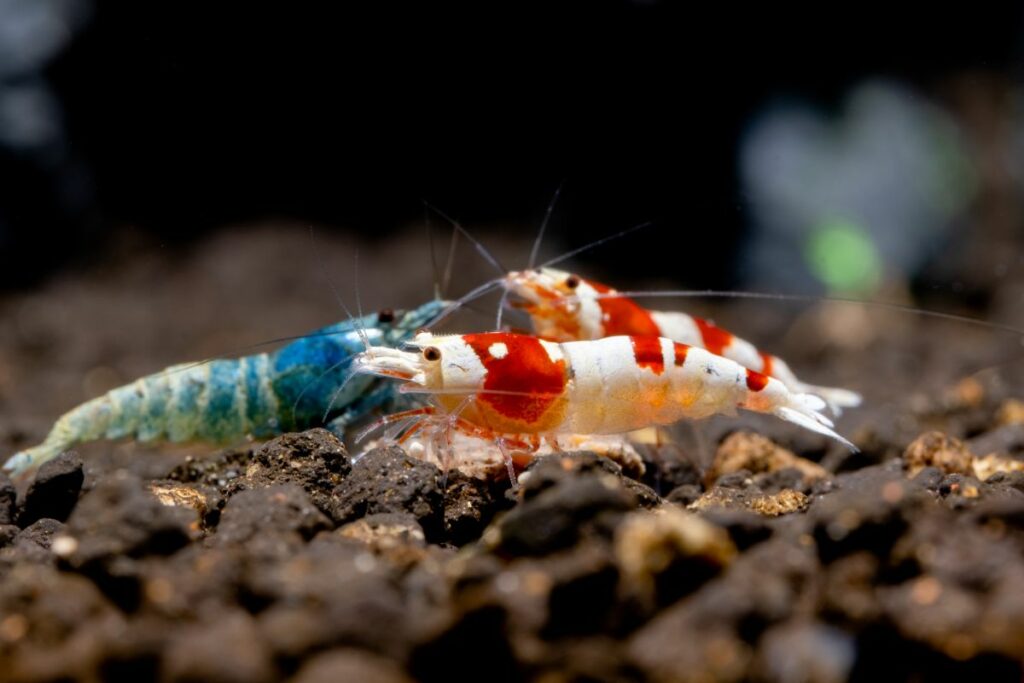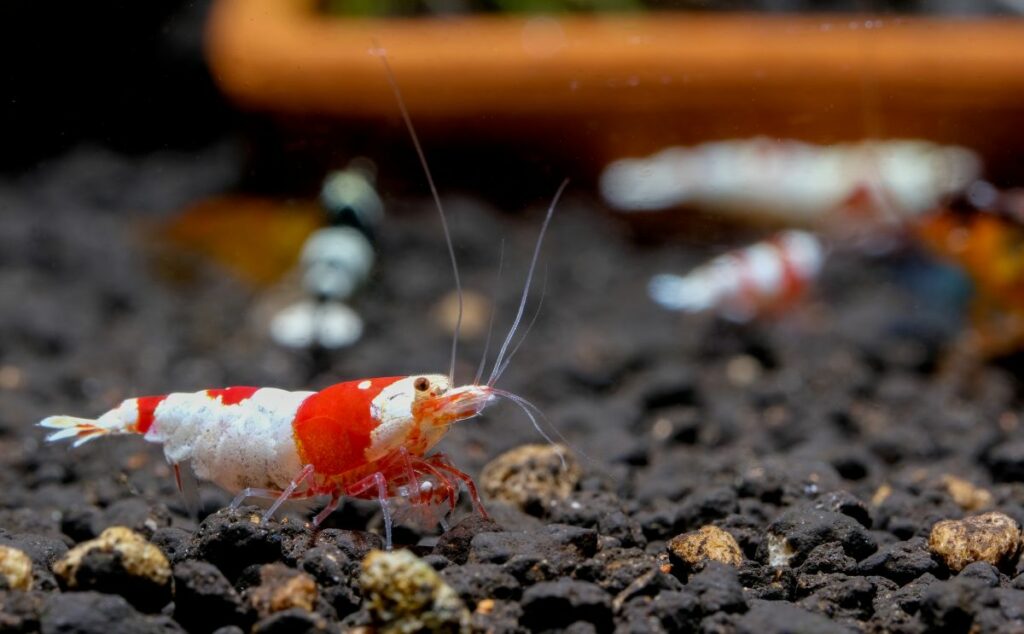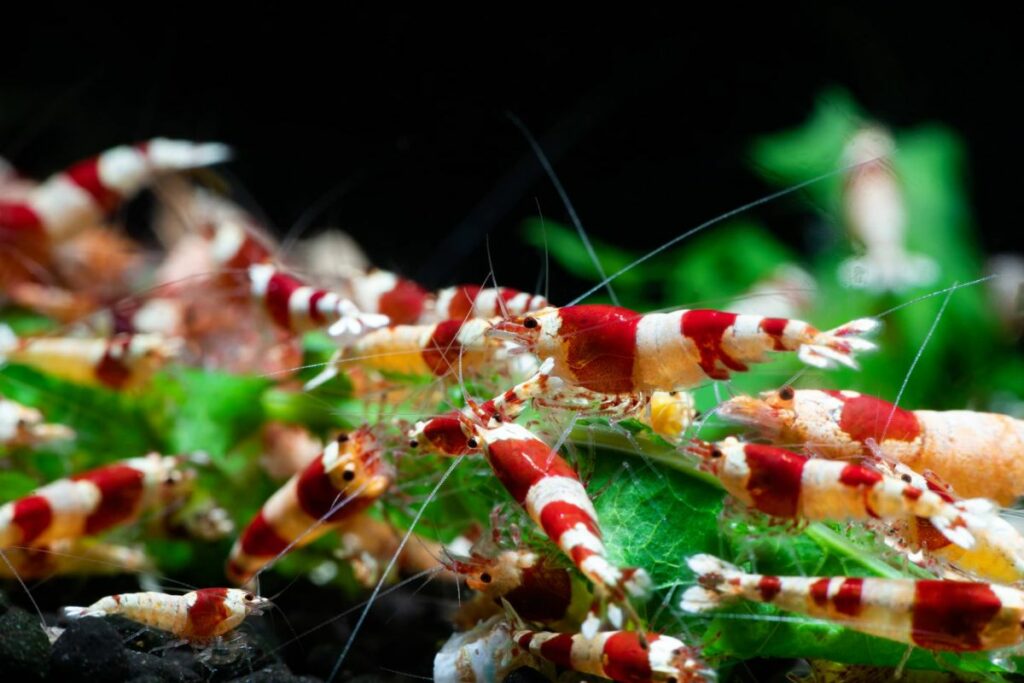Caridina shrimp is one of the most popular shrimp species kept by aquarists. Their bright colors and interesting patterns make them stand out in any aquarium. Once they feel comfortable in their new tank, they are quite active. These shrimp are some of the most entertaining animals in a home aquarium.

Caridina shrimp look a lot like Neocaridina shrimp. Caridina shrimp are less hardy and better suited for experienced shrimp keepers. There are far more varieties of Caridina than Neocaridina shrimp. Caring for them can be very rewarding and entertaining.
Maintaining a stable environment with the correct parameters is crucial.
Continue reading to learn how to care for these shrimp. We’ll cover their tank, water quality, and diet requirements.
What Are Caridina Shrimp?
Caridina shrimp are freshwater shrimp with a variety of vibrant colors and patterns. They are sometimes known as “bee shrimp,” for short.
Caridina shrimp are tiny animals whose size varies based on the species. Most are between 0.3-1.7 in (1-4.5 cm) long.
These shrimp have a pair of chelipeds, or claws, at the front of their body. Their chelipeds have bristles at the tips that filter detritus and microorganisms. The shrimp use these while searching for food.
Common Names: Caridina shrimp, bee shrimp
Scientific Name: Caridina sp.
Origin: Southeast Asia — Thailand
Size (Length): 0.3-1.7 in (1-4.5 cm)
Lifespan: 1-2 years
Aquarium Size: 5+ years
Temperament: Peaceful
Ease of Care: Moderate
Caridina Shrimp Types
There are over 300 types of caridina shrimp worldwide. Each species has many varieties and colorations.
Some of the most popular Caridina species include:
- Amano shrimp (Caridina multidentata)
- Bee shrimp (Caridina cantonensis)
- Blue bolt shrimp (Caridina cantonensis)
- Crystal black shrimp (Caridina cantonensis)
- Crystal red shrimp (Caridina cantonensis)
- King Kong shrimp (Caridina cf cantonensis)
- Pinocchio shrimp (Caridina gracilirostris)
- Red nose shrimp (Caridina gracilirostris)
- Shadow panda shrimp (Caridina cantonensis var. Panda)
- Sulawesi shrimp (Caridina dennerli)
- Tangerine tiger shrimp (Caridina serrata)
- Tiger shrimp (Caridina mariae or Caridina serrata)
How Long Do Caridina Shrimp Live?
Caridina shrimp have short lifespans; most only live for one to two years.
Caridina VS Neocaridina Shrimp
It’s nearly impossible to tell Caridina and Neocaridina shrimp apart by looking at them. Most experts must view the shrimp under a microscope to tell the two apart. Still, they have their fundamental differences.
Neocaridina shrimp are hardier. they are better suited for beginning aquarium keepers than Caridina shrimp. They are not as sensitive to water parameters and need less maintenance.
Caridina shrimp are more particular about their water quality. They need soft water to remain healthy.
Habitat
Most Caridina shrimp are native to Southeast Asian countries, particularly Thailand. Some populations live in parts of Africa and Oceania.
They inhabit slow-moving rivers, streams, lakes, and ponds with dense vegetation. The rivers they live in are generally in the highlands with cooler water.
They spend most of their time at the bottom of these habitats where the substrate is muddy or sandy.
Behavior & Temperament
These shrimp are a peaceful species that is non-aggressive and non-territorial. They are shy and fearful due to their size, so they spend most of their day hiding.
Caridina shrimp are active when they feel safe, climbing over vegetation and rocks.
Diet
Caridina shrimp are omnivorous scavengers. They search around the bottom of their habitats for food.
They are detritivores that eat waste products. Waste includes leftover fish food and decaying plant or animal matter.
They are not picky and will eat almost anything they come across.
Reproduction

Caridina shrimp have short lifespans. They become sexually mature at only three to four months old.
There isn’t much information on the reproductive habits of Caridina shrimp. Their reproductive habits are likely similar to Neocaridina shrimp.
Females carry their eggs with their swimming legs, or pleopods. They carry the eggs under their abdomen until they’ve developed. Females with eggs have a yellowish-orange mass under their abdomen. In the aquarium trade, egg-carrying females are referred to as “berried.”
Molting
Shrimp do not grow with their shells; rather, they outgrow their old shells and produce new ones. Shrimp have exoskeletons: external coverings that are rigid and protective.
In a process called “molting,” the shrimp shed their old shells. Their newly-formed shells are quite soft for a while. Their soft shells leave them fragile and more susceptible to predation. Shrimp hide directly after molting until their new shell hardens.
Care
Caridina shrimp are moderately-difficult to care for. They are sensitive and have specific care requirements. They aren’t the best animals for beginners.
Aquarists don’t need to be experts to care for these shrimp. Yet, they should have prior aquarium-keeping experience.
Many kinds of Caridina shrimp exist, but most have the same care requirements. The care listed below is suitable for most Caridina species. Research the specific variety before buying to see if its care differs.
Tank Size & Water Conditions
The minimum tank size for caridina shrimp is five gallons, but larger is always better.
Those without much aquarium-care experience should consider opting for a larger tank. 10 to 15 gallons is suitable. Maintaining stable conditions in larger tanks is easier than in smaller ones.
Due to their size, Caridina shrimp produce very little bioload. Aquarists can safely house 2-5 caridina shrimp per gallon of water.
Water Hardness
Caridina shrimp are sensitive to water quality. They are picky about water temperature, pH, and water hardness. Neocaridina shrimp are a bit more forgiving.
Caridina shrimp must live in soft water with a dGH between 3 and 6.
Aquarists may need to equip their system with a reverse osmosis (RO) system.
Simply, reverse osmosis filters unwanted ions and particles from the water.
Reverse osmosis purifies the water. It also removes good minerals that fish and inverts need to stay healthy.
Aquarists using an RO system need to add minerals back into their water.
pH
Reverse osmosis water is slightly more acidic than most tap water. The pH is generally between 6.0-6.5.
Caridina shrimp need a pH between 6.0 and 8.0. Most types need a pH closer to 7.0.
* Some caridina shrimp, like the blue tiger and Amano shrimp, prefer a pH below 7.0. *
Water Temperature
These shrimp need water temperatures between 68-74°F (20-24°C).
They can live within this range. Still, caretakers should not allow the temperature to fluctuate. Fluctuations can stress or shock the shrimp. Temperatures should remain as stable as possible.
Higher temperatures give the shrimp a higher metabolism. They eat more and grow faster. Temperatures must be higher for the shrimp to breed more quickly and frequently. Yet, shrimp have shorter lifespans at higher temperatures.
Caridina shrimp still breed at lower temperatures; they do so less often. Offspring bred in lower temperatures tend to be healthier.
Shrimp living in lower temperatures eat less and live longer. They also tend to have more vibrant colors and patterns.
Decorations
Shrimp are skittish prey animals who spend most of their time hiding. Provide them with lots of vegetation, caves, rocks, and driftwood. Decorations also grow algae, giving the shrimp something to snack on.
Heaters
Caridina shrimp need temperatures between 68-74°F (20-24°C). Caretakers will likely need a water heater.
Room temperature water is suitable in environments where the air doesn’t drop below 70°F (21.1°C). The temperature shouldn’t fluctuate much, either.
Heaters are best, even for aquarium keepers that live in warmer climates. They keep the water temperature stable, which is essential to the health of these shrimp.
Opt for a heater with an adjustable temperature setting for better control. Always keep a thermometer in the water and check the temperature every day. Heater malfunctions are rare but can be fatal to shrimp and fish.
Filters
Filters are necessary for shrimp aquariums to keep the water healthy and clean.
Simple sponge filters are best for shrimp tanks because they create a gentle flow. They are safer for shrimp as they prevent the tiny animals from being sucked inside the filter.
Sponge filters usually create a stream of bubbles. Bubbles are necessary for providing the tank with oxygen. The amount of flow produced by sponge filters is usually ideal and won’t cause stress.
Chemical filtration is less common in sponge filters but is useful when available. Chemical filtration, like activated carbon, helps remove contaminants like ammonia.
Aquarium keepers must use caution when using filters other than sponge filters. Equip intake valves with sponges or fine wire mesh. These prevent shrimp from being sucked into the filter.
It’s best to use an adjustable filter in case the flow is too much so that aquarists can adjust the stream.
Cleaning
Caridina shrimp are excellent algae eaters and detritivores. They spend most of their days scavenging the substrate and decorations. Caridina shrimp will eat leftover fish food, biofilm, and algae. They help with the clean-up of the tank.
Still, aquarium keepers shouldn’t rely on their shrimp to keep their tanks clean. Aquariums need regular cleaning, at least two to four times a month.
Clean The Substrate
Use a gravel vacuum or a turkey baster to suck out the old water, poop, and fish food. Be careful not to suck up the shrimp, especially when using a gravel vacuum.
Water Changes
Remove 15-30% of the water when doing water changes. Avoid removing more than 30% of the water, as the new water can shock the shrimp. Sensitive caridina shrimp don’t handle shock well, and it can be fatal.
Tank Walls & Decorations
Clean the tank walls and decorations with an aquarium sponge to remove debris and algae. NEVER use soap or chemicals when cleaning the tank.
Filters
Sponge filters need cleaning about once a month. Save some of the water from the water change in a bucket. Gently shake the sponge in the old water to release the dirt trapped inside. Never rinse a sponge filter in tap water; it kills the beneficial bacteria growing inside.
Those with chemical filtration need to change the filtration once a month.
Lighting
Caridina shrimp are not picky about the amount of light they receive. They do as well in low light as they do in bright light. Most aquarists set up their lights to achieve the best plant growth.
Aquarists keeping their shrimp with fish should bear the fish’s needs in mind first. Most fish are sensitive to overly bright lights and do better with dim or moderate lighting.
Feeding

Feed caridina shrimp pellets or algae wafers two to three times a week. Although they eat detritus and algae, it’s rarely enough for them to live on.
Blanched vegetables are highly nutritious. They make a great supplement to the pellets or wafers.
Safe blanched vegetables include:
- Spinach
- Cucumbers
- Carrots
- Lettuce
- Zucchini
Remove leftover food no more than two hours after feeding your shrimp. Old food begins to decompose and dirty the water, causing the ammonia to spike. Such spikes are hazardous for fish and shrimp.
Calcium Supplements
It’s good to provide caridina shrimp with calcium supplements. The easiest way to do this is to add a small piece of cuttlebone to the tank.
Cuttlebones come from cuttlefish and are chock-full of calcium. The cuttlebone slowly dissolves in the water column. They supply the shrimp with calcium for several weeks. Calcium is necessary for keeping their exoskeletons healthy. Most pet stores sell cuttlebones in the bird section.
Indian Almond Leaves
Indian almond leaves are another great addition to the water. They release tannins, healthy compounds found in leaves. They boost the water quality and the immune health of the tank’s inhabitants. The shrimp will also pick at the leaves and eat their contents.
* Be sure to remove Indian almond leaves once they begin to break down. Like any organic material, they can cause a spike in ammonia as they die. *
Tank Mates
Caridina shrimp are social animals who feel more comfortable in groups. At the bare minimum, they should live in groups of four individuals. Groups of ten or more individuals are better where possible.
The more shrimp aquarists keep in their tanks, the more enjoyable the aquarium will be. Shrimp feel safer in numbers. They are more active in large groups and less likely to hide.
These shrimp can live in some community tanks. Safe tank mates are peaceful fish and other invertebrates. Avoid large, aggressive animals.
Fish and invertebrates safe to house with Neocaridina shrimp include:
- Small tetras (e.g., neon tetras, lemon tetras, ember tetras, etc.)
- Small danios
- Platys
- Emerald dwarf rasboras
- Blue-eyed rainbowfish
- Small catfish (e.g., corydoras, upside-down catfish, bumblebee catfish)
- Dwarf gouramis
- Small snails (e.g., mystery snails, apple snails, nerite snails)
- Other shrimp species (e.g., ghost shrimp, Amano shrimp, vampire shrimp)
NEVER house Neocaridina shrimp with these animals:
- Cichlids
- Oscars
- Discus
- Large plecos
- Large tetras
- Mollies
Breeding
Breeding happens naturally. Still, some aquarists prefer to set up the ideal conditions to entice breeding.
Provide the shrimp with more hiding spots than usual, including driftwood and vegetation. Having more hiding places makes the adults feel more secure during mating. It also provides more safety to juveniles, especially if other species are in the tank.
In the wild, these shrimp breed during summer. Aquarists should raise the temperature slightly. Feed them a higher protein diet than usual to prepare them for the egg-laying process.
Caridina shrimp are skittish animals that take a while to warm up to their environment. Don’t expect new shrimp to begin mating immediately. It can take several months for shrimp to feel comfortable in their new home to start mating.
Common Problems
As sensitive animals, Caridina shrimp are prone to specific problems. Mainly, they are prone to parasites and molting issues.
Molting Problems
Caridina shrimp frequently molt as they grow, getting rid of their old shell in place of a larger one. Poor water quality or fluctuations can stress them out and cause molting issues.
The most dangerous molting issue is the “white ring of death.” The exoskeleton splits in two, and the shrimp cannot crawl out when needed. They can get stuck inside their shell, which eventually becomes fatal.
The shell can also break at odd angles, making it difficult for the shrimp to crawl out.
Keeping the tank clean and stable is the best way to prevent molting problems. Caretakers should also consider adding calcium supplements, like cuttlebone, to the tank.
Parasites
Parasites are commonly caused by poor tank conditions or fluctuating parameters. Parasites multiply and spread quickly and can be fatal if left untreated.
Unfortunately, it’s more challenging to treat parasites in shrimp than in fish. Many parasite-treating medications contain ingredients toxic to shrimp.
Consult a veterinarian to determine the type of parasite ailing the shrimp and the best way to treat it.
Keeping the tank clean and stable is the best way to prevent parasites. Always quarantine new shrimp for at least two weeks before adding them to the main tank.
* Be very careful when treating the tank with any medications or chemicals. Shrimp and other invertebrates are much more sensitive to additives than fish. Avoid copper, malachite green, and CO2. *
Caridina Shrimp Care, In A Nutshell
Consult this Caridina shrimp care sheet for quick care tips:
| Caridina Shrimp Care | |
| Aquarium Size | 5+ gallons (add 1 gallon per additional 1-3 shrimp) |
| Water Temperature | 68-74°F (20-24°C) |
| pH | 6.0-8.0 |
| Water Hardness | 3-6 dGH |
| Safe Water Levels | Ammonia: 0 ppm Nitrites: 0 ppm Nitrates: <10 ppm |
| Lighting | No preference |
| Decorations | Pebbles Crevices Aquatic vegetation |
| Tank Mates | Necessary — groups of 10+ shrimp ideal Small, non-aggressive fish & inverts okay |
| Diet | Omnivorous (algae wafers & blanched vegetables) |
FAQs
Caridina shrimp are some of the more expensive varieties of freshwater shrimp. The cheapest shrimp variety is often about $5 an individual. The most expensive types can sell for upward of $50 for a single individual.
Sometimes, it’s cheaper to buy these shrimp in packs. They must live in large groups, and retailers often offer a deal when buying in bulk. Most standard Caridina shrimp packs range from $50 to $150 and may contain 10+ shrimp.
Caridina shrimp are relatively easy to find due to their popularity. Many online retailers sell high-quality Caridina shrimp. Buyers can sometimes find them in person at their local fish store. Neocaridina shrimp are more common in fish stores.
Cherry shrimp are Neocaridina, not Caridina, shrimp. Cherry shrimp are hardier than Caridina shrimp. They are better suited for beginning shrimp owners. They are very common and come in four different grades. Cherry shrimp are considered higher quality the redder their bodies are.
Caridina shrimp of the same species and genus will interbreed. The first few generations may be quite interesting in color and variation. After a few generations, the offspring will all begin to look similar.
Caridina shrimp will not interbreed with Neocaridina or other shrimp species.
Ghost shrimp are not Caridina shrimp; they are part of the Palaemonetes species. Their scientific name is Palaemonetes paludosus.
Ghost shrimp are transparent animals that are slightly larger than Caridina shrimp. They are less desirable and cheaper than Caridina and Neocaridina shrimp. Pet stores often sell them for a few cents as feeders for larger organisms.
Researchers once thought ghost shrimp were part of the Caridina species. Today, we know they are not even part of the same family.
